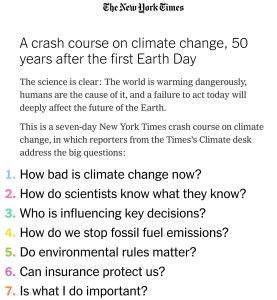Зарегистрируйтесь на getAbstract, чтобы получить доступ к этому краткому изложению.

Зарегистрируйтесь на getAbstract, чтобы получить доступ к этому краткому изложению.
Henry Fountain, Kendra Pierre-Louis, Hiroko Tabuchi, Brad Plumer, Lisa Friedman, Christopher Flavelle and Somini Sengupta
A Crash Course on Climate Change
50 years after the first Earth Day
The New York Times, 2020
Что внутри?
If you’re feeling overwhelmed by climate change, here’s what you need to know in a nutshell.
Recommendation
Wondering how big the problem of global warming is, say, compared to the novel coronavirus? Wonder no more. This compelling summary of climate science and policy makes it clear that the world is currently on a path to catastrophe, but quick and strategic changes can minimize harm. From making personal choices that reduce greenhouse gas emissions to supporting policies that incentivize emissions-curtailing societal changes, seven concise, though somewhat scattershot, Q&As make it clear what people can – and must – do to head off an environmental and economic crisis of pandemic proportions.
Summary
About the Authors
Henry Fountain, Kendra Pierre-Louis, Hiroko Tabuchi, Brad Plumer, Lisa Friedman, Christopher Flavelle and Somini Sengupta are reporters for The New York Times climate desk.



















Comment on this summary